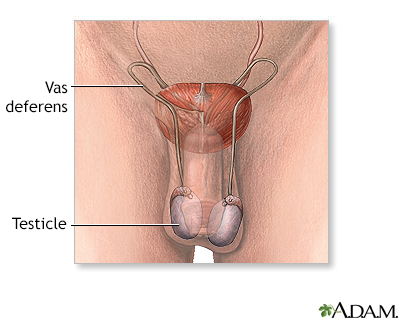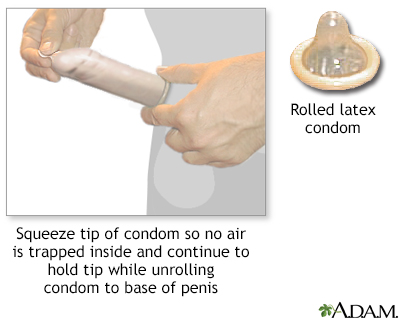Pregnancy SmartSiteTM
Prophylactics; Rubbers; Male condoms; Contraceptive - condom; Contraception - condom; Barrier method - condom DefinitionA condom is a thin cover worn on the penis during intercourse. Using a condom will help prevent:
Condoms for women can also be purchased. InformationThe male condom is a thin cover that fits over a man's erect penis. Condoms are made of:
Condoms are the only method of birth control for men that are not permanent. They can be purchased at most drugstores, in vending machines in some restrooms, by mail order, and at certain health care clinics. Condoms do not cost very much. HOW DOES A CONDOM WORK TO PREVENT PREGNANCY? If the sperm contained in a male's semen reach a woman's vagina, pregnancy may occur. Condoms work by preventing sperm from coming in contact with the inside of the vagina. If condoms are used correctly every time intercourse occurs, the risk of pregnancy is around 3 out of every 100 times. However, there is a higher chance of pregnancy if a condom:
Condoms do not work as well at preventing pregnancy as some other forms of birth control. However, using a condom is much better than not using birth control at all. Some condoms contain substances that kill sperm, called a spermicide. These may work slightly better to prevent pregnancy. A condom also prevents the spread of certain viruses and bacteria that cause diseases.
HOW TO USE A MALE CONDOM The condom must be put on before the penis comes into contact with the outside of the vagina or enters the vagina. If not:
The condom must be put on when the penis is erect, but before contact is made between the penis and vagina.
IMPORTANT TIPS Make sure you have condoms around when you need them. If no condoms are handy, you may be tempted to have intercourse without one. Use each condom only once. Store condoms in a cool, dry place away from sunlight and heat.
If you feel a condom break during intercourse, stop right away and put on a new one. If semen is released into the vagina when a condom breaks:
PROBLEMS WITH CONDOM USE Some complaints or problems with condom use include:
ReferencesCenters for Disease Control and Prevention website. How to use a condom. www.cdc.gov/condom-use/resources/external.html?CDC_AAref_Val=https://www.cdc.gov/condomeffectiveness/external-condom-use.html. Updated April 3, 2024. Accessed June 19, 2024. Pepperell R. Sexual and reproductive health. In: Symonds I, Arulkumaran S, eds. Essential Obstetrics and Gynaecology. 6th ed. Philadelphia, PA: Elsevier; 2020:chap 19. Swygard H, Cohen MS. Approach to the patient with a sexually transmitted infection. In: Goldman L, Cooney KA, eds. Goldman- Cecil Medicine. 27th ed. Philadelphia, PA: Elsevier; 2024:chap 264. Workowski KA, Bachmann LH, Chan PA, et al. Sexually Transmitted Infections Treatment Guidelines, 2021. MMWR Recomm Rep. 2021:23;70(4):1-187. PMID: 34292926 pubmed.ncbi.nlm.nih.gov/34292926/. | |
| |
Review Date: 10/13/2023 Reviewed By: Linda J. Vorvick, MD, Clinical Professor, Department of Family Medicine, UW Medicine, School of Medicine, University of Washington, Seattle, WA. Also reviewed by David C. Dugdale, MD, Medical Director, Brenda Conaway, Editorial Director, and the A.D.A.M. Editorial team. The information provided herein should not be used during any medical emergency or for the diagnosis or treatment of any medical condition. A licensed medical professional should be consulted for diagnosis and treatment of any and all medical conditions. Links to other sites are provided for information only -- they do not constitute endorsements of those other sites. No warranty of any kind, either expressed or implied, is made as to the accuracy, reliability, timeliness, or correctness of any translations made by a third-party service of the information provided herein into any other language. © 1997- A.D.A.M., a business unit of Ebix, Inc. Any duplication or distribution of the information contained herein is strictly prohibited. | |

 Male reproductive ...
Male reproductive ... The male condom
The male condom
